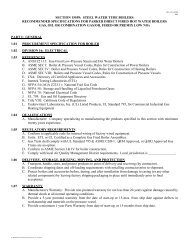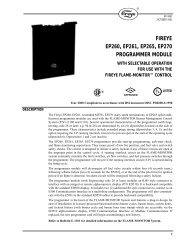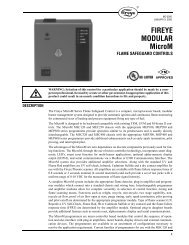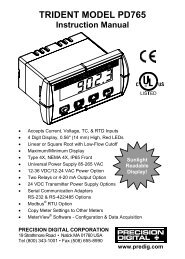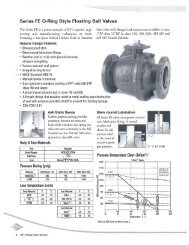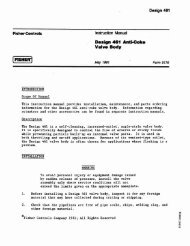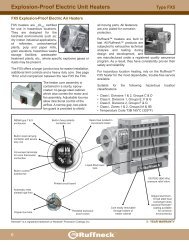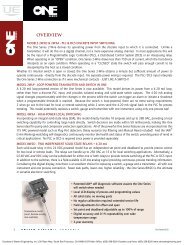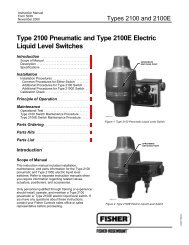ethylene Glycol MEGlobal_MEG.pdf
ethylene Glycol MEGlobal_MEG.pdf
ethylene Glycol MEGlobal_MEG.pdf
Create successful ePaper yourself
Turn your PDF publications into a flip-book with our unique Google optimized e-Paper software.
Ethylene <strong>Glycol</strong>Product Guide
Table of ContentsINTRODUCTION2...........Precautions2...........About <strong><strong>MEG</strong>lobal</strong>2...........Doing Business With Us2...........Service2...........Products and Applications3...........Ethylene <strong>Glycol</strong> – The Versatile Performer4...........Table 1: Applications5...........Responsible Care ®6...........Non-Supported Applications of <strong><strong>MEG</strong>lobal</strong> Ethylene <strong>Glycol</strong> ProductsPROPERTIES7...........Table 2: Physical Properties of Ethylene <strong>Glycol</strong>8...........Table 3: Solubilities of Various Materials in Ethylene <strong>Glycol</strong>9...........Table 4: Ethylene <strong>Glycol</strong> Compatibility with Elastomeric Materials10.........Table 5: Constant Boiling Mixtures11.........Table 6: Volume Percent vs. Weight Percent of Aqueous Ethylene <strong>Glycol</strong> Solutions at 68°F (20°C)12.........Figure 1: Conversion Chart of Aqueous Solutions of Ethylene <strong>Glycol</strong> at 68°F (20°C)13.........Figure 2: Freezing Points of Aqueous Ethylene <strong>Glycol</strong> Solutions14.........Figure 3: Boiling Points vs. Composition of Aqueous Ethylene <strong>Glycol</strong> Solutions at Various Pressures15.........Figure 4: Condensation Temperatures vs. Composition of Aqueous Ethylene <strong>Glycol</strong>Solutions at Various Pressures16.........Figure 5: Vapor Pressures of Ethylene <strong>Glycol</strong> at Various Temperatures17.........Figure 6: Vapor Pressures of Aqueous Ethylene <strong>Glycol</strong> Solutions at Various Temperatures18.........Figure 7: Viscosities of Aqueous Ethylene <strong>Glycol</strong> Solutions19.........Figure 8: Specific Heats of Aqueous Ethylene <strong>Glycol</strong> Solutions20.........Figure 9: Thermal Conductivities of Aqueous Ethylene <strong>Glycol</strong> Solutions21.........Figure 10: Dew Points of Aqueous Ethylene <strong>Glycol</strong> Solutions at Various Contact Temperatures22.........Figure 11: Surface Tensions of Pure Ethylene <strong>Glycol</strong> at Various Temperatures23.........Figure 12: Surface Tensions of Aqueous Ethylene <strong>Glycol</strong> Solutions at 77°F (25°C)24.........Figure 13: Refractive Indices of Pure Ethylene <strong>Glycol</strong> at Various Temperatures25.........Figure 14: Refractive Indices of Aqueous Ethylene <strong>Glycol</strong> Solutions at 77°F (25°C)26.........Figure 15: Dielectric Constant of Aqueous Ethylene <strong>Glycol</strong> Solutions27.........Figure 16: Electrical Conductivities of Aqueous Ethylene <strong>Glycol</strong> Solutions28.........Figure 17: Specific Gravities of Aqueous Ethylene <strong>Glycol</strong> Solutions29.........Figure 18: Comparative Hygroscopicities at Various <strong>Glycol</strong>s at 70°F (21°C)30.........Health Effects30.........Environmental Information30.........Storage and Handling30.........Shipping Data for Ethylene <strong>Glycol</strong>31.........Product Safety32.........Emergency Service33.........Sales OfficeEthylene <strong>Glycol</strong> 1
INTRODUCTIONPrecautionsCarefully review our current Material Safety Data Sheets.Ethylene glycol can be toxic if ingested. To preventaccidental poisonings in humans and animals, pleaseensure proper storage and disposal of materials containing<strong>ethylene</strong> glycol.About <strong><strong>MEG</strong>lobal</strong><strong><strong>MEG</strong>lobal</strong> TM is a world leader in the manufacture andmarketing of merchant mono<strong>ethylene</strong> glycol (<strong>MEG</strong>) anddi<strong>ethylene</strong> glycol (DEG), collectively known as EG.Established in July 2004, the company is a joint venturebetween The Dow Chemical Company and PetrochemicalIndustries Company of Kuwait and is headquartered inLondon, England. <strong><strong>MEG</strong>lobal</strong> produces about 1.0 millionmetric tons per year of EG, and markets in excess of 2.5million metric tons of EG per year. With approximately200 employees worldwide, <strong><strong>MEG</strong>lobal</strong> serves customersaround the world.<strong><strong>MEG</strong>lobal</strong> is committed to being the preferred and lowcostsupplier of <strong>MEG</strong> and DEG for customers worldwide.Doing Business With UsIn addition to our corporate offices in London, England,and our production facilities, we operate commercialservice locations in Hong Kong, Switzerland and theUnited States. Our knowledgeable, local professionalsare native to the regions they work in, so they speak yourlanguage, know your culture, and understand your needs.World-class technical service and support are availablethrough our highly trained sales representatives.Products and Applications<strong><strong>MEG</strong>lobal</strong>’s advanced manufacturing process is based onmore than 70 years of experience, and is characterizedby seamless integration, catalyst efficiency, and localaccess to feedstock. With our total approach to continuousimprovement in quality and quality systems, we fully meetthe stringent ISO 9001 series of standards, allowing us todeliver the high-quality products you require.Optimum performance demands a quality product, andthat is what we deliver. Our vast distribution system ofplants, terminals, tankers, barges, tankcars and truckshelps to ensure delivery of <strong>ethylene</strong> glycol and di<strong>ethylene</strong>glycol when and where you need it.Our <strong>MEG</strong> can be used for applications that requirechemical intermediates for resins, solvent couplers,freezing point depression, solvents, humectants andchemical intermediates. These applications are vital to themanufacture of a wide range of products, including resins;deicing fluids; heat transfer fluids; automotive antifreezeand coolants; water-based adhesives, latex paints andasphalt emulsions; electrolytic capacitors; textile fibers;paper and leather.The characteristics of our DEG products supplement our<strong>MEG</strong> portfolio, augmenting our capabilities to includeapplications that require hygroscopicity, lubricants andlow volatility. Products that capitalize on these and otherDEG properties include plasticizers; glass- and cementgrindingaids; printing ink; drywall joint compound;thermoplastic polyurethanes and emulsifiers.For more information on our DEG products, please referto our <strong><strong>MEG</strong>lobal</strong> Di<strong>ethylene</strong> <strong>Glycol</strong> Product Guide.ServiceFor solutions to problems or answers to questions, takeadvantage of <strong><strong>MEG</strong>lobal</strong> technical service and support,available through trained sales representatives. Yourorder of <strong>ethylene</strong> glycol will be processed expertly andquickly when you place a call to one of our many helpfulcustomer service representatives (See page 33).Ethylene <strong>Glycol</strong> 2
Ethylene <strong>Glycol</strong> – The Versatile PerformerEthylene <strong>Glycol</strong>:HOCH 2CH 2OHCAS Registry Number:107-21-1Synonyms:1, 2-Ethanediol<strong>Glycol</strong>EGMono<strong>ethylene</strong> glycolEthylene glycol is a colorless, practically odorless,low-volatility, low-viscosity, hygroscopic liquid. It iscompletely miscible with water and many organic liquids.The hydroxyl groups on glycols undergo the usualalcohol chemistry, giving a wide variety of possiblederivatives. Hydroxyls can be converted to aldehydes,alkyl halides, amines, azides, carboxylic acids, ethers,mercaptans, nitrate esters, nitriles, nitrite esters, organicesters, peroxides, phosphate esters and sulfate esters.This chemistry permits <strong>ethylene</strong> glycol to act as anintermediate in a wide range of reactions. Especiallysignificant is resin formation, including the condensationwith dimethyl terephthalate or terephthalic acid resultingin a polyester resin.The reactivity and solubility of <strong>ethylene</strong> glycol providethe basis for many applications. The widespread use of<strong>ethylene</strong> glycol as an antifreeze is based on its abilityto lower the freezing point when mixed with water. Thephysical properties of <strong>ethylene</strong> glycol-water mixtures aretherefore extremely important. The end uses for <strong>ethylene</strong>glycol are numerous (See Table 1).Ethylene <strong>Glycol</strong> 3
Responsible Care<strong><strong>MEG</strong>lobal</strong> embraces and advocates Responsible Care ® , avoluntary industry-wide commitment to safely handle ourchemicals from inception in the laboratory to ultimatedisposal. We take this commitment very seriously since itfocuses on continuous improvement in not only employeehealth and safety, but also a cleaner environment for ouremployees, customers and the public.Additionally, our environmental, health and safety policiesrequire, as a minimum, full compliance with all applicablelaws and regulations.Our employees are held to a rigid set of health and safetyrequirements. They are expected to commit to ourEmployee Health and Safety policy (EH&S) as <strong><strong>MEG</strong>lobal</strong>’snumber-one priority; to work to achieve zero personal-safetyincidents and leak-free facilities; and to proactivelyidentify and resolve EH&S issues. This kind of seriousaccountability helps us ensure the highest possible level ofEH&S throughout the company.<strong><strong>MEG</strong>lobal</strong> products are easy to store and handle. Ofcourse, we provide current Material Safety Data Sheetsthat contain complete safety information for all of ourproducts, but we also supply vital health, safety andenvironmental information through presentations,literature and access to a wide variety of other referencematerials and information resources to give our customersthe comprehensive knowledge they need to concentrate onprocess safety, emergency response and other areas vitalto their health and safety and to the environment.Our Product Stewardship philosophy gives us a means toassess information on the potential health and environmentalimpacts of our products, helping us to take whatever stepsare necessary to protect our employees, customers, thepublic and the environment.Responsible Care ® is a registered trademark of the Canadian Chemical Producers’ AssociationEthylene <strong>Glycol</strong> 5
Non-Supported Applications of <strong><strong>MEG</strong>lobal</strong> Ethylene <strong>Glycol</strong> ProductsThe following bullet points identify some applications thatare NOT supported by <strong><strong>MEG</strong>lobal</strong> for <strong>ethylene</strong> glycol orwhere its use is restricted by regulation. The reasons forthese limitations include areas which <strong><strong>MEG</strong>lobal</strong> hasdecided not to pursue for general business reasons and tominimize unnecessary risk and liabilities to the company.In addition, the following list of applications not supportedby <strong><strong>MEG</strong>lobal</strong> does not imply a <strong><strong>MEG</strong>lobal</strong> warranty or<strong><strong>MEG</strong>lobal</strong> support of uses in applications not covered bythis list. This list is not all-inclusive.• The use of <strong><strong>MEG</strong>lobal</strong> <strong>ethylene</strong> glycol products inthe production of tobacco and in the manufacture oftobacco products (including but not limited to additives,humectants, filters, inks and paper) is not supported by<strong><strong>MEG</strong>lobal</strong>.• The use of <strong><strong>MEG</strong>lobal</strong> <strong>ethylene</strong> glycol products for thegeneration of artificial smoke/theatrical fogs/mist is notsupported by <strong><strong>MEG</strong>lobal</strong>.• The use of <strong><strong>MEG</strong>lobal</strong> <strong>ethylene</strong> glycol products asingredient in fuel for warming foods (Sterno TM -likeapplication) or in fuel for heating an enclosed spacewhere human exposure is possible is not supported by<strong><strong>MEG</strong>lobal</strong>.• The use of <strong><strong>MEG</strong>lobal</strong> <strong>ethylene</strong> glycol products in fireextinguishing sprinkler systems is not supported by<strong><strong>MEG</strong>lobal</strong>.• The use of <strong><strong>MEG</strong>lobal</strong> <strong>ethylene</strong> glycol products in themanufacture of munitions is not supported by <strong><strong>MEG</strong>lobal</strong>.• The use of <strong><strong>MEG</strong>lobal</strong> <strong>ethylene</strong> glycol products in theproduction of deicers for use on roadways and sidewalksis not supported by <strong><strong>MEG</strong>lobal</strong>.• The use of <strong><strong>MEG</strong>lobal</strong> <strong>ethylene</strong> glycol products as acomponent of heat transfer fluids in systems where theheat transfer fluids could infiltrate (e.g., via an exchangerleak, backflow prevention failure or other means) apotable water system.• The use of <strong><strong>MEG</strong>lobal</strong> <strong>ethylene</strong> glycol products as a nonreactedcomponent in a formulation for direct internal orexternal human contact, including, but not limited toingestion, inhalation, and skin contact and in themanufacture of medical devices is not supported by<strong><strong>MEG</strong>lobal</strong>. (Examples of some such applications areuses as a direct component in foods, beverages,pharmaceuticals, cosmetics, or personal care products.)• The use of <strong><strong>MEG</strong>lobal</strong> <strong>ethylene</strong> glycol products fordeodorizing or air “purifying” purposes by spraying asan aerosol is not supported by <strong><strong>MEG</strong>lobal</strong>.• The use of <strong><strong>MEG</strong>lobal</strong> <strong>ethylene</strong> glycol products as anon-reacted component in adhesives, plasticizers andsoftening agents for food packaging that has directcontact with food is not supported by <strong><strong>MEG</strong>lobal</strong>.To enter into new applications beyond the traditionalstandard industrial use applications, contact your<strong><strong>MEG</strong>lobal</strong> representative to review the specificapplication. <strong><strong>MEG</strong>lobal</strong> has a risk assessment processwhereby the application will be reviewed and adetermination will be made as to whether the applicationmeets <strong><strong>MEG</strong>lobal</strong>’s requirements and can therefore besupported by <strong><strong>MEG</strong>lobal</strong>. Because use conditions andapplicable laws may differ from one location to anotherand may change with time, when an application issupported by <strong><strong>MEG</strong>lobal</strong>, <strong><strong>MEG</strong>lobal</strong> does not warrant andis not responsible for the use in such applications.NO WARRANTIES ARE GIVEN; ALL IMPLIEDWARRANTIES OF MERCHANTABILITY OR FITNESSFOR A PARTICULAR PURPOSE ARE EXPRESSLYEXCLUDED.Further, any violation of or failure to comply with theinformation contained in <strong><strong>MEG</strong>lobal</strong>’s Material SafetyData Sheet, Product Label, Product Information Guide,product literature or other product safety information is amisuse of <strong><strong>MEG</strong>lobal</strong>’s <strong>ethylene</strong> glycol products. Thesedocuments can be obtained by contacting your <strong><strong>MEG</strong>lobal</strong>representative or <strong><strong>MEG</strong>lobal</strong>’s Customer Service (see page33). We can never specify all circumstances where misusemight occur, so if at any time a customer or downstreamuse appears to be improper or unsafe, please contact our<strong><strong>MEG</strong>lobal</strong> Customer Service (see page 33).Ethylene <strong>Glycol</strong> 6
PROPERTIESMany of the present uses of <strong>ethylene</strong> glycol are based onits properties as a freezing point depressant, but <strong>ethylene</strong>glycol is also valuable in applications that depend uponone or more additional properties. The ease with which itreacts with other chemical intermediates plus its solvent,lubricant, plasticizing and hygroscopic properties are allresponsible for its popularity as an industrial raw material.Table 2: Physical Properties of Ethylene <strong>Glycol</strong>ScientificCommonAutoignition Temperature 427°C 801°FCritical Pressure 8,200 kPa 61,505 mm HgCritical Specific Volume 0.191 L/gmol 3.06 ft 3 /lbmolCritical Temperature 446.85°C 836.33°FDielectric Constant at 25°C 37.7 37.7Electrical Conductivity at 20°C 1.07 x 10 -6 mhos/cm 1.07 micromhos/cmEvaporation Rate (Butyl Acetate = 1) 0.01 0.01Flash Point, Closed Cup(Pensky-Martens Closed Cup ASTM D93) 126.7°C 260°FFlash Point, Open Cup(Cleveland Open Cup ASTM D92) 137.8°C 280°FHeat of Combustion at 25°C -1,053 kJ/gmol -7,297 Btu/lbHeat of Formation at 25°C -460 kJ/gmol -3,188 Btu/lbHeat of Fusion 9.96 kJ/gmol 69 Btu/lbHeat of Vaporization at 1 atm 53.2 kJ/gmol 369 Btu/lbMolecular Weight 62.07 g/mol 62.07 g/molNormal Boiling Point 197.1°C 386.8°FΔ BP/Δ P (750 to 770 mm Hg) 0.337°C/kPa 0.045°C/mm HgNormal Freezing Point -13°C 8.6°FOnset of Initial Decomposition 240°C 464°FRefractive Index, n D, at 25°C 1.4306 1.4306Solubility in Water at 20°C 100 wt% 100 wt%Solubility of Water in Ethylene <strong>Glycol</strong> at 20°C 100 wt% 100 wt%Specific Gravity (20/20°C) 1.1153 1.1153Δ Specific Gravity/Δ T(10 to 40°C) 0.00070 per °C 0.00039 per °FSurface Tension at 25°C 48.0 mN/m 48.0 dynes/cmVapor Density (air = 1) 2.1 2.1Vapor Pressure at 20°C 0.0075 kPa 0.06 mm HgEthylene <strong>Glycol</strong> 7
Table 3: Solubilities of Various Materials in Ethylene <strong>Glycol</strong>Solubility, g/100 mL of Ethylene <strong>Glycol</strong> at 25°CAcetone Completely Soluble Lard Oil InsolubleAnimal Glue (Dry) Slightly Soluble Linseed Oil InsolubleBenzene 6.0 Methanol Completely SolubleCarbon Tetrachloride 6.6 Methyl Orange 1.8Castor Oil Insoluble Monoethanolamine Completely SolubleCellulose Acetate Insoluble Nitrocellulose InsolubleChlorobenzene 6.0 Olive Oil InsolubleCoconut Oil Insoluble o-Dichlorobenzene 4.7Cottonseed Oil Insoluble Paraffin Oil InsolubleDextrin (10% water) Soluble Phenol Completely SolubleDextrin Slightly Soluble Pine Oil Completely SolubleDibutyl Phthalate 0.5 Rosin Slightly SolubleDichloroethyl Ether 11.8 Shellac Slightly SolubleDiethanolamine Completely Soluble Soya Bean Oil Slightly SolubleEthyl Ether 8.9 Sperm Oil Slightly SolubleEthylene <strong>Glycol</strong> Distearate Slightly Soluble Tall Oil 1.1Gum Damar Slightly Soluble Toluene 3.1Heptane Slightly Soluble Tung Oil InsolubleHydrous Wool Fat Slightly Soluble Turkey Red Oil 3.3Kauri Gum Slightly Soluble Urea 44.0Ethylene <strong>Glycol</strong> 8
Table 4: Ethylene <strong>Glycol</strong> Compatibility withElastomeric MaterialsTemperatureMaterial 25°C (77°F) 80°C (176°F) 160°C (320°F)Adiprene TM L-100 Good Poor PoorBlack Rubber 3773 Good Poor PoorBuna N (or Buna 25) Good GoodBuna S Good Poor PoorButyl Rubber Good GoodCompressed Asbestos Good Good FairEPDM Good Good GoodEPR Rubber Good Good GoodHycar TM D-24 Good PoorHypalon TM Good Poor PoorKalrez TM Good Good GoodNatural Rubber Gum Good Poor PoorNeoprene 7797 Good PoorRed Rubber Number 107 Good Poor PoorSaraloy TM 300 Good Poor PoorSilicone No. 65 Good GoodThiokol TM 3060 Fair Poor PoorViton TM A Good Good PoorEthylene <strong>Glycol</strong> 9
Table 5: Constant Boiling MixturesComponentsAzeotropeEthylene <strong>Glycol</strong> 1.1153 197.1 196.2 72.5 1.074Butyl CARBITOL TM Solvent 0.9556 231.0 27.5Ethyl <strong>Glycol</strong> 1.1153 197.1 139.5 6.4 2.0 99.0 U 95.0 U 0.777Butyl Ether 0.7697 141.0 93.6 98.0 1.0 L 5.0 L 1.114Ethylene <strong>Glycol</strong> (50 mm Hg) 1.1153 123.6 (a) 92.7 (a) U 9.92-Chloroethyl Ether 1.2215 96.05 (a) L 90.1Ethylene <strong>Glycol</strong> 1.1153 197.1 178.0 26.1 0.959Diethyl CARBITOL TM Solvent 0.9098 189.0 73.9Ethylene <strong>Glycol</strong> (100 mm Hg) 1.1153 139.5 (a) 121.0 (a) 18.0Diisopropylethanolamine 0.8760 127.5 (a) 82.00.918Ethylene <strong>Glycol</strong> (50 mm Hg) 1.1153 123.6 (a) 104.0 (a) 15.0Diisopropylethanolamine 0.8760 110.6 (a) 85.00.908Ethylene <strong>Glycol</strong> (10 mm Hg) 1.1153 91.3 (a) 74.0 (a) 10.0Diisopropylethanolamine 0.8760 77.8 (a) 90.00.894Ethylene <strong>Glycol</strong>CARBITOL TM Solvent1.1153 197.10.9970 201.6192.0 45.554.51.050Ethylene <strong>Glycol</strong> (100 mm Hg) 1.1153 139.5 (a) 134.0 (a) 33.0CARBITOL TM Solvent 0.99007 137.3 (a) 67.01.0305Ethylene <strong>Glycol</strong> (50 mm Hg) 1.1153 123.6 (a) 112.8 (a) 35.6 0.1 99.9 U 71.8 U 0.795Hexyl Ether 0.7937 140.0 (a) 64.4 99.9 0.1 L 28.2 L 1.115Ethylene <strong>Glycol</strong> 1.1153 197.1 192.0 30.0 1.051Methyl CARBITOL TM Solvent 1.0247 193.6 70.0Ethylene <strong>Glycol</strong> (200 mm Hg) 1.1153 157.1 (a) 149.0 (a) 12.0Methyl CARBITOL TM Solvent 1.0247 150.3 (a) 88.01.033Ethylene <strong>Glycol</strong> (50 mm Hg) 1.1153 123.6 (a) 114.0 (a) 4.0Methyl CARBITOL TM Solvent 1.0247 114.4 (a) 96.01.025Ethylene <strong>Glycol</strong> 1.1153 197.1 192.3 64.5 0.22 98.28 U 35.3 (c) U 1.068 (b)Phenyl Ether 1.0658 (b) 258.3 35.5 99.78 1.72 L 64.7 (c) L 1.108 (b)Ethylene <strong>Glycol</strong> (50 mm Hg) 1.1153 123.6 (a) 120.4 (a) 62.3 0.2 98.5 U 37.6 U 1.076Phenyl Ether 1.0658 (b) 158.0 (a) 37.7 99.8 1.5 L 62.4 L 1.114Ethylene <strong>Glycol</strong> 1.1153 197.1 110.1 2.3 0.1 97.0 U 98.2 U 0.866Toluene 0.8700 110.6 97.7 99.9 3.0 L 1.8 L 1.110Ethylene <strong>Glycol</strong> 1.1153 197.1 135.7 6.9 0.08 98.3 U 94.5 U 0.865o-Xylene 0.8814 144.4 93.1 99.92 1.7 L 5.5 L 1.113(a) At the pressure investigated;(b) At 30/20°C;(c) At 30°C.SpecificGravity at20/20°CBoilingPoint at760mm Hg,°CBoilingPoint at760mm Hg,°CComposition, % by Wt at 20°CIn In InAzeo- Upper Lowertrope Layer LayerRelativeVolume ofLayers at20°C, %SpecificGravity at20/20°C ofAzeotropeor LayersEthylene <strong>Glycol</strong> 10
Table 6: Volume Percent vs. Weight Percent ofAqueous Ethylene <strong>Glycol</strong> Solutions at68°F (20°C)<strong>Glycol</strong>, % byWt Vol Wt Vol Wt Vol Wt Vol Wt Vol1 0.90 21 19.25 41 38.39 61 58.37 81 79.262 1.80 22 20.18 42 39.37 62 59.40 82 80.333 2.70 23 21.12 43 40.35 63 60.42 83 81.404 3.60 24 22.07 44 41.33 64 61.45 84 82.485 4.51 25 23.01 45 42.32 65 62.48 85 83.556 5.41 26 23.96 46 43.30 66 63.51 86 84.637 6.32 27 24.90 47 44.29 67 64.54 87 85.718 7.23 28 25.85 48 45.28 68 65.58 88 86.809 8.15 29 26.80 49 46.28 69 66.62 89 87.8810 9.06 30 27.76 50 47.27 70 67.66 90 88.9711 9.98 31 28.71 51 48.27 71 68.70 91 90.0712 10.89 32 29.67 52 49.27 72 69.75 92 91.1613 11.81 33 30.63 53 50.27 73 70.80 93 92.2614 12.74 34 31.59 54 51.28 74 71.85 94 93.3515 13.66 35 32.56 55 52.29 75 72.90 95 94.4616 14.59 36 33.53 56 53.30 76 73.95 96 95.5617 15.51 37 34.49 57 54.31 77 75.01 97 96.6718 16.44 38 35.46 58 55.32 78 76.07 98 97.7719 17.38 39 36.44 59 56.34 79 77.13 99 98.8920 18.31 40 37.41 60 57.35 80 78.20 100 100.00Please note that the above calculations were performed assuming that water + <strong>ethylene</strong> glycol form an ideal mixture:V M = V 1 + X 2 V 2 , where V = molar volume.Ethylene <strong>Glycol</strong> 11
Figure 1: Conversion Chart of Aqueous Solutions ofEthylene <strong>Glycol</strong> at 68°F (20°C)Ethylene <strong>Glycol</strong> 12
Figure 2: Freezing Points of Aqueous Ethylene<strong>Glycol</strong> SolutionsFurther information on the freezing points of <strong>ethylene</strong> glycol-water mixtures can be found in an articleby D.R. Cordray, L.R. Kaplan, P.M. Woyciesjes and T.F. Kozak entitled, “Solid-Liquid Phase Diagram forEthylene <strong>Glycol</strong> + Water,” published in Fluid Phase Equilibria 117, pp. 146-152 (1996).Ethylene <strong>Glycol</strong> 13
Figure 3: Boiling Points vs. Composition of AqueousEthylene <strong>Glycol</strong> Solutions at Various PressuresEthylene <strong>Glycol</strong> 14
Figure 4: Condensation Temperatures vs. Compositionof Aqueous Ethylene <strong>Glycol</strong> Solutions atVarious PressuresEthylene <strong>Glycol</strong> 15
Figure 5: Vapor Pressure of Ethylene <strong>Glycol</strong> at VariousTemperaturesEthylene <strong>Glycol</strong> Antoine Constants for Calculating Vapor Pressure3–Constant EquationA = 8.21211 Range = 20 to 198°CB = 2161.91P = mm HgC = 208.43 T = °CLog 10(P) = A – B/(T + C)5–Constant EquationA = 84.09 Range = 260.15 to 720°KB = 10411P = PaC = 0.0T = KelvinD = -8.1976E = 1.6536 x 10 -18N = 6In (P) = A – B/(T + C) + D (In (T)) + ET NEthylene <strong>Glycol</strong> 16
Figure 6: Vapor Pressures of Aqueous Ethylene <strong>Glycol</strong>Solutions at Various TemperaturesEthylene <strong>Glycol</strong> Antoine Constants for Calculating Vapor Pressure3-Constant EquationLog 10(P) = A – B/(T + C)P = mm HgT = °CEG, Wt% A B C0 7.966820 1668.210 228.00050 7.901886 1691.452 229.77870 7.833380 1712.369 231.16680 7.775839 1736.188 232.68990 7.685032 1792.464 235.83695 7.856193 2019.846 251.89897 8.123192 2273.083 267.91098 8.384100 2493.364 279.58499 9.189807 3103.597 309.713100 8.212109 2161.907 208.429Ethylene <strong>Glycol</strong> 17
Figure 7: Viscosities of Aqueous Ethylene <strong>Glycol</strong>SolutionsLog 10 (Viscosity, cP) = A – B/(x + C)x = Weight % Ethylene <strong>Glycol</strong>T, °F A B C-50 -0.782928 516.030 -219.294-40 -1.089569 556.509 -228.728-30 -1.327771 586.133 -236.676-20 -1.673072 666.763 -252.223-10 -2.598652 992.919 -295.4990 -2.255218 817.542 -279.93310 -2.789821 1029.329 -310.41630 -3.770236 1495.186 -368.93050 -4.489869 1941.309 -422.768100 -3.968390 1596.092 -420.283150 -3.619555 1368.620 -420.761200 -3.552380 1341.596 -442.146250 -3.695975 1491.089 -487.664300 -3.789550 1626.778 -532.123350 -4.411432 2357.689 -655.745Ethylene <strong>Glycol</strong> 18
Figure 8: Specific Heats of Aqueous Ethylene <strong>Glycol</strong>SolutionsSpecific Heats = A + BT + CT 2T = Temperature, °CEG, Wt% A B C0 1.00380 -2.2459E -4 2.6257E -610 0.97236 1.8001E -4 5.7049E -720 0.93576 3.9963E -4 0.030 0.89889 5.1554E -4 0.040 0.85858 6.2639E -4 0.050 0.81485 7.3219E -4 0.060 0.76768 8.3293E -4 0.070 0.71707 9.2863E -4 0.080 0.66304 1.0193E -3 0.090 0.60557 1.1049E -3 0.0100 0.54467 1.1854E -3 0.0Ethylene <strong>Glycol</strong> 19
Figure 9: Thermal Conductivities of Aqueous Ethylene<strong>Glycol</strong> SolutionsThermal Conductivity = A + BT + CT 2T = Temperature, °CEG, Wt% A B C0 0.32247 1.1524E -3 -4.3629E -610 0.30433 8.9729E -4 -3.6114E -620 0.28697 6.6350E -4 -2.9292E -630 0.27038 4.5096E -4 -2.3160E -640 0.25455 2.5973E -4 -1.7722E -650 0.23951 8.9758E -5 -1.3975E -660 0.22523 -5.8962E -5 -8.9196E -770 0.21172 -1.8633E -4 -5.5597E -780 0.19898 -2.9247E -4 -2.8895E -790 0.18701 -3.7733E -4 -9.1152E -8100 0.17581 -4.4092E -4 3.7445E -8Ethylene <strong>Glycol</strong> 20
Figure 10: Dew Points of Aqueous Ethylene <strong>Glycol</strong>Solutions at Various Contact TemperaturesDew or Frost Point = A + BTT = Temperature, °CEG, Wt% A B50.0 -3.532 0.9653060.0 -5.043 0.9513070.0 -7.231 0.9313080.0 -10.663 0.9002090.0 -17.081 0.8420095.0 -23.575 0.7781097.0 -28.124 0.7285098.0 -31.807 0.6979099.0 -37.996 0.6570099.5 -43.626 0.6110099.8 -50.671 0.55450Ethylene <strong>Glycol</strong> 21
Figure 11: Surface Tensions of Pure Ethylene <strong>Glycol</strong> atVarious TemperaturesSurface Tension, dynes/cm = 50.206 – 0.089TT = Temperature, °CEthylene <strong>Glycol</strong> 22
Figure 12: Surface Tensions of Aqueous Ethylene <strong>Glycol</strong>Solutions at 77°F (25°C)Surface Tension, dynes/cm at 77°F (25°C) = 71.536 – 0.39671x + 0.001625x 2X = Weight % Ethylene <strong>Glycol</strong>Ethylene <strong>Glycol</strong> 23
Figure 13: Refractive Indices of Pure Ethylene <strong>Glycol</strong> atVarious TemperaturesRefractive Index = 1.4370 – 0.00026TT = Temperature, °CEthylene <strong>Glycol</strong> 24
Figure 14: Refractive Indices of Aqueous Ethylene<strong>Glycol</strong> Solutions at 77°F (25°C)Refractive Index = 1.3325 + 0.000982xx = Weight % Ethylene <strong>Glycol</strong>Ethylene <strong>Glycol</strong> 25
Figure 15: Dielectric Constant of Aqueous Ethylene<strong>Glycol</strong> SolutionsDieclectric Constant = A + Bx + Cx 2x = Weight % Ethylene <strong>Glycol</strong>T, °C A B C20 79.752 -0.18962 -0.002182440 72.670 -0.20795 -0.001668360 66.330 -0.21942 -0.001264280 60.408 -0.22728 -0.0009121100 55.067 -0.22807 -0.0006596Ethylene <strong>Glycol</strong> 26
Figure 16: Electric Conductivities of Aqueous Ethylene<strong>Glycol</strong> SolutionsEthylene <strong>Glycol</strong>, Wt %0 5.89E -65 1.33E -510 1.58E -520 1.41E -530 1.16E -540 6.28E -650 5.09E -660 3.50E -670 2.76E -680 1.79E -690 1.17E -6100 3.30E -6Electrical Conductivity, mhos/cmNote: The quality of water used for dilution can significantly affect electrical conductivityEthylene <strong>Glycol</strong> 27
Figure 17: Specific Gravities of Aqueous Ethylene<strong>Glycol</strong> SolutionsSpecific Gravity (T/60°F) = A + Bx + Cx 2X = Weight % Ethylene <strong>Glycol</strong>T (°F) A B C-50 0.95801 3.4535E -3 -1.5015E -50 0.98147 2.4980E -3 -9.1168E -650 0.99873 1.6424E -3 -4.0019E -6100 0.99284 1.4017E -3 -2.9868E -6150 0.98017 1.2599E -3 -2.3334E -6200 0.96344 1.1610E -3 -1.8084E -6250 0.94445 9.6829E -4 0.0300 0.91974 9.7284E -4 0.0350 0.89171 9.9650E -4 0.0Ethylene <strong>Glycol</strong> 28
Figure 18: Comparative Hygroscopicities of Various<strong>Glycol</strong>s at 70°F (21°C)% Water (Based on Dry Humectant), at EquilibriumEthylene <strong>Glycol</strong>, % by Weight in Water% Relative HumidityEthylene <strong>Glycol</strong> 29
Health EffectsEthylene glycol can be harmful or fatal if misused. Seeour current Material Safety Data Sheet for health, first aid,exposure limits and toxicology information.Environmental InformationEthylene glycol should be treated effectively inconventional wastewater treatment plants and should notpersist in the environment. See our current Material SafetyData Sheet for toxicity information.BiodegradationFor information concerning the biodegradability of<strong>ethylene</strong> glycol, please refer to the latest Material SafetyData Sheet.Storage and HandlingEthylene glycol is commonly stored and handled in steelequipment. This product is compatible with any othercommonly used materials of construction. Tanks thathave been lined with baked phenolic or epoxy-phenoliccoatings have been used, as have fiberglass-reinforcedplastic tanks and stainless steel tanks. Aluminum hasbeen used at low temperatures (about 104°F or 40°C,maximum), but is not recommended where the aluminumcontainer is heated. Zinc or galvanized iron is notrecommended, and copper or copper alloys may causeproduct discoloration. Galvanized iron and tin or tinnedsteel should not be used.For long-term storage, or if trace iron contamination andthe development of color are objectionable in the glycol,a storage vessel lined with a baked-phenolic resin, an airdryingepoxyphenolic resin, or a vinyl resin or a stainlesssteel or aluminum tank is suggested. Zinc or galvanizediron is not recommended, and copper or copper alloysmay cause product discoloration. Galvanized iron and tinor tinned steel should not be used.An inert gas in the vapor space of storage tanks is notgenerally required since <strong>ethylene</strong> glycol has a highboiling point, and the vapors in the tanks are relativelynon-flammable. However, if extremely low water contentis required, consistent with long-term storage (e.g., withpolyester and low conductivity grades), a nitrogen blanketcan be used to exclude atmospheric moisture and toprotect against UV quality degradation. Since <strong>ethylene</strong>glycol is hygroscopic, a dry gas pad should be maintainedin the vapor space of the tank if moisture pickup isto be minimized. The inert gas prevents air oxidation(to glycolic acid) to maintain product within acidityspecifications. Increased acidity enhances iron pickupfrom steel vessels.Pure <strong>ethylene</strong> glycol freezes at about 9°F (-13°C). In coldclimates, the storage tanks and lines will require heatingand insulation unless they are located inside a heatedbuilding or underground.To maintain product quality, polyester and lowconductivity grades should be stored under a slightpositive pressure of inert gas, typically nitrogen.Shipping Data forEthylene <strong>Glycol</strong>Weight per Gallon at 20°C9.29 lbCoefficient of Expansion at 55°C 0.00065Flash Point, Tag Closed Cup 260°FNet Contents and Type of Container1–Gallon Tin Can9.0 lb5–Gallon DOT 17E, Pail55–Gallon DOT 17E, Drum47 lb519 lbAll bulk shipments of <strong>ethylene</strong> glycol (5,000 lbs or more) are regulated bythe U.S. Department of Transportation; therefore, the DOT shipping name is“Other Regulated Substances, Liquid, NOS.” The technical name is “ContainsEthylene <strong>Glycol</strong>” and the hazard classification is “9.” The DOT warning labelor identification number is “NA 3082.”Ethylene <strong>Glycol</strong> 30
Product SafetyWhen considering the use of <strong>ethylene</strong> glycol in anyparticular application, review and understand our currentMaterial Safety Data Sheet for the necessary safety andenvironmental health information. For Material SafetyData Sheets and other product safety information on<strong><strong>MEG</strong>lobal</strong> products, contact the <strong><strong>MEG</strong>lobal</strong> sales officenearest you. Before handling any products mentionedin this booklet, you should obtain the available productsafety information from the suppliers of those productsand take the necessary steps to comply with allprecautions regarding the use of <strong>ethylene</strong> glycol.No chemical should be used as or in a food, drug, medicaldevice, or cosmetic, or in a product process in which itmay come in contact with a food, drug, medical device,or cosmetic until the user has determined the suitabilityof the use. Because use conditions and applicable lawsmay differ from one location to another and may changewith time, Customer is responsible for determiningwhether products and the information in this documentare appropriate for Customer’s use and for ensuringthat Customer’s workplace and disposal practices are incompliance with applicable laws and other governmentalenactments.<strong><strong>MEG</strong>lobal</strong> requests that the Customer read, understandand comply with the information contained in thispublication and the current Material Data Safety Sheet(s).Customer should furnish the information in this publicationto its employees, contractors and customers, or any otherusers of the product(s), and request that they do the same.Ethylene <strong>Glycol</strong> 31
Emergency Service<strong><strong>MEG</strong>lobal</strong>, through The Dow Chemical Company, maintains an around-the-clock emergency service for itsproducts. The Chemical Manufacturers Association (CHEMTREC), Transportation Canada (CANUTEC),and the Chemical Emergency Agency service maintain an around-the-clock emergency service for allchemical products.Location <strong><strong>MEG</strong>lobal</strong> Products All Chemical ProductsMainland United States Phone Dow HELP: Phone CHEMTREC:and Puerto Rico +1 800-822-4357 (toll-free) +1 800-424-9300 (toll-free)Alaska and Hawaii Phone Mainland United States: Phone CHEMTREC:+1 304-744-3487 (collect) +1 800-424-9300 (toll-free)Canada Phone Dow: Phone CANUTEC:+1 514-640-6400 (collect) +1 613-996-6666 (collect)Continental Europe, Middle East, Phone BIG (Geel-Belgium):Phone CHEMTRECNorth and Central Africa +32 14-58-45-45 (United States):+1 703-527-3887 (collect)United Kingdom and Ireland Phone National Chemical Phone CHEMTRECEmergency Center (Culham-UK): (United States):+44 1865-407-333 +1 703-527-3887 (collect)Latin America, Asia/Pacific, Phone United States: Phone CHEMTRECSouth Africa and any other +1 304-744-3487 (collect) (United States):location, worldwide+1 703-527-3887 (collect)If you are at seaRadio U.S. Coast Guard, who can directly contactDow HELP +1 800-822-4357 (toll-free) orCHEMTREC +1 800-424-9300 (toll-free)DO NOT WAIT. Phone if in doubt. You will be referred to a specialist for advice.Ethylene <strong>Glycol</strong> 32
Sales OfficeFor additional information, contact our Customer Service Center:Customer ServiceGeographical AreaPhoneArgentina +54 11-4319-0328BoliviaChileParaguayPeruUruguayAsia +852-2879-7273Brazil +55 11-5188-9681Venezuela +52 55-5201-4874ColombiaMexico +52 55-5201-4720Europe+41 44-728-2493 orSouth America +41 44-728-2596North America(toll-free)+1 888-610-9048Middle East +917 4508-8126IndiaPakistanTurkey +90 216-571-1600NOTICE: No freedom from any patent owned by Seller or others is to be inferred. Because use conditions and applicable laws may differ from onelocation to another and may change with time, Customer is responsible for determining whether products and the information in this documentare appropriate for Customer’s use and for ensuring that Customer’s workplace and disposal practices are in compliance with applicable laws andother governmental enactments. Seller assumes no obligation or liability for the information in this document. NO WARRANTIES ARE GIVEN;ALL IMPLIED WARRANTIES OF MERCHANTABILITY OR FITNESS FOR A PARTICULAR PURPOSE ARE EXPRESSLY EXCLUDED.001-00005-0508-CRCG© 2008 The <strong><strong>MEG</strong>lobal</strong> Group of Companies. All Rights Reserved.Ethylene <strong>Glycol</strong> 33



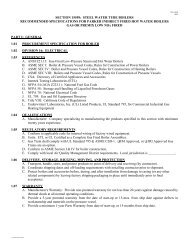
![ratings & DEFINITIONS452-467_Technical Information[1].pdf](https://img.yumpu.com/49871719/1/190x245/ratings-definitions452-467-technical-information1pdf.jpg?quality=85)
